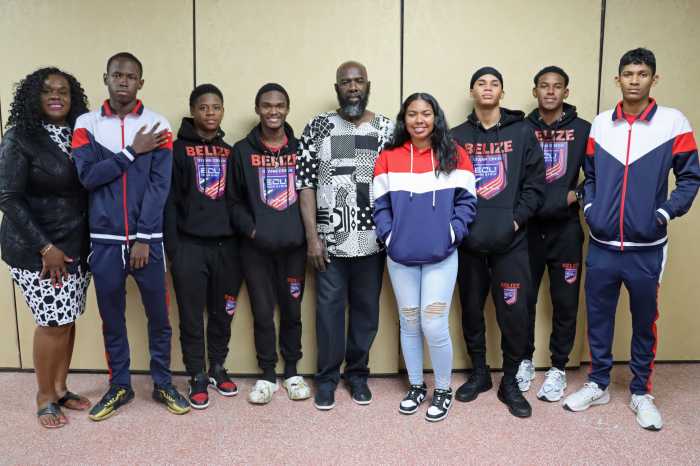The annual Garifuna Settlement Day celebration, which was founded in 1942 by visionary Garifuna leader Thomas Vincent Ramos, is the foremost event to remind the Garinagu people about their genesis, exodus, and survival against historical odds that were meant to exterminate their existence and identity as a people. The celebration also occurs in the Garifuna diaspora and on different dates at Garifuna communities in Honduras (April 12), Guatemala (Nov. 26) and Nicaragua. This year’s celebration theme is: “Awanse wamá lidan aban lau lareini bungiu luma habayarahan áhari. (Let us progress in unity with God’s goodness and the protection of our ancestors.”
Arguably, without the pause for reflection that this day brings, the people’s collective memory of significant events in their experience would have long been destroyed by colonial forces. Hence the importance of all to be cognizant of the old West African proverb, “Until the lion and lioness learn to keep their history, the history of the hunting will always glorify the hunter.”
One’s history must not only expand the awareness of the prevailing impact of past values and conditions on life today. Its lessons must be used to guide present and future realities. The experiences of our ancestors have a lot to teach us.
The popular history about the genesis of the Garinagu is that in 1635, two Spanish ships loaded with captured Africans (men and women) from the Bight of Benin in West Africa and destined for enslavement on plantations in the Caribbean, were wrecked by a storm off the island of Bequia in the St.Vincent Grenadines. Most of these Africans survived the wreck and crossed over from Bequia to mainland St Vincent where they found a home and intermingled among the Island Caribs who had helped in their rescue.
That history, however, is simplistic and distorts a much more complex reality. Ivan Van Sertima’s thesis argues the presence, in the Americas, of Africans from the Mali Empire during the 13th century. This was long before the encounter by “Chris-teef-us Come-bus us”. Be that as it may, the most significant series of events that has had the most profound impact on the character, history and contemporary Caribbean began with the flood of Europeans, starting with Columbus, who for over four centuries exploited every resource while cruelly subjugating enslaved Africans and indigenous people to fulfill their desire for material enrichment.
There were reports, such as in Nancie Gonzalez’s Sojourners of the Caribbean, of contact between island Caribs of Dominica and enslaved Africans occurring in the late 1500s and that such contact was also likely to have also occurred with St. Vincent Caribs several generations before the shipwreck.
Slavery was brutal. It included severe whippings by European masters, severing of body parts, hanging, or throwing slaves in boiling cauldrons of cane syrup. Many escaped. Over time there was a constant increase in the number pure-bred Africans who fled enslavement in Barbados and other islands to nearby St Vincent where the indigenous Caribs provided a sanctuary. The flow of ocean currents, wind, and short distance made it relatively easy for escapees to reach St. Vincent in small crafts. By the end of the 1700s the Black Carib (Garinagu) population on St. Vincent had grown considerably.
These two groups of people – the Africans and the indigenous bronze-colored Caribs – came to share a culture of resistance that was necessitated by the realities of the times in which they were living. The Garinagu were forced to defend their territory, their freedom and their existence from marauding Europeans greedy for expansion of their colonial possessions and determined to acquire these at any cost and by any means necessary.
As early as 1772, the Garinagu vowed that they would never submit or give up their lands and preferred to die first. After several failed attempts at cajolery and intimidation to remove them from their land, the British engaged full force. In 1796, the Garinagu fought fiercely but were no match for the superior military might of the British.
When they refused to surrender, they were hunted down, their houses and canoes were burned, and their crops and food were destroyed. Between July 1796 and February 1797, about 4,338 Garifuna (mostly women and children) were captured and transported to the barren rock island of Baliceaux. There, about 2,100 died from typhus or yellow fever, which was aggravated by malnutrition.
On March 11, 1797, the 2,238 Garifuna survivors embarked in a convoy of ships to be banished forever on the island of Roatan hundreds of miles away. (Those who remained in St. Vincent were strictly forbidden from any expression of their culture.) Over two hundred died on that perilous one month voyage. On April 12, 1797, 2,026 Garinagu (664 men and 1,362 women and children) were landed on Roatan and left to the mercy of the elements. These stalwart ancestors formed the root stock of the estimated 400,000 Garifuna people and their richly unique culture that we have today.
From their first settlement at Roatan these survivors spread to mainland Honduras where, gradually through baptism of their offspring to Roman Catholicism their family names such as Huayba, Palangure, Babiar, Sambula, Chatuye, among others, were changed, as the church required, to their Spanish compadre’s surnames such as Arzu, Castillo, Palacio, Cayetano, Enriquez, Ramos and others that they now have today.
On August 1802, five years after the war and their expulsion from St Vincent, a group of 150 Garifuna were imported to the settlement of Belize to cut mahogany for the British forestocracy. This importation was necessitated by the shortage of labor due to the escape of enslaved Africans from the settlement to nearby Petén and Mexico. Technically, the Garinagu were not allowed in Belize. They were considered dangerous and there was fear that they would foment slave rebellion. Hence it was mandated that all Garinagu must remain completely outside the settlement, south of its Sibun River boundary.
The first Garifuna settlement was Dangriga. From there they spread further south through the vast expanse of uninhabited forest and coastline all the way to the Sarstoon River extracting mahogany. (Interestingly, both Afro-descendant groups whose labor enriched the empire remain marginalized.) ON November 19, 1823, there was the mass influx of Garinagu to Belize with others continuing to join family members over the years. They became well known for their resilience, self-reliance, courage, diverse productive skills, natural intelligence, strong work ethic and superb maritime skills.
Since their arrival, the Garinagu have continued to make outstanding contributions to the development of Belize though various fields most notably agriculture, education and culture. This remarkable story of Garifuna survival and progress while defending and maintaining their distinct ancestral culture and language through all odds speaks to the strong determination, resilience and unity of purpose of the ancestors.
Today the Garifuna people are faced with a new set of complex challenges that will define whether or not they have the determination, commitment, strength and visionary leadership that enabled the survival of their ancestors.
The subtle downplay of our African ancestry by some leaders, while highlighting mainly that of the indigenous Caribs, (historically done with apparent intention to distinguish a difference between former enslaved and free Afro-descendants) distorts and undervalues the equally rich contributions of our African legacy. Such denial stifles the critical need for concerted approaches by both Belizean Afro-descendant groups to confront common adversities that continue to marginalize both groups. Divisive political party loyalties over the greater interests of our people have polarized families and communities while compromising the call for unifying and transformative leadership so desperately needed among our people. Issues of discrimination, historically exploitative socio-economic opportunities, poverty, lack of self-reliant productivity, alcoholism, poor dietary habits and diabetes, apathy, disengagement of the diaspora, competing cultural interests, all continue to affect our people. In a profound way, the threats that we face starts from conditions within our individual and collective consciousness and values.
Perhaps what is being increasingly lost is the deep spirituality that was central to Garifuna survival and progress, and the passing on of timeless values from the ancestors through each generation. In the days of our ancestors, the leaders served as healers, counselor, custodian of the people’s cultural values, and spiritual warriors to protect the people from danger. They realized that the desire for the greater good of their people is drawn from spiritual sustenance. The leaders had unwavering integrity to resist cajolery and bribery by the British against their people. They were shrewd, reflective and insightful, united, and looked out for each other and the greater good of all. Through these timeless values, they realized (as in the spirit of Ubuntu) that the well-being of each is inextricably linked to that of the other. If these values become increasingly absent among our young men and women, our people’s future well-being will continue to be threatened.
To maintain the values that have preserved and strengthened a people amidst most challenging times, the long journey that we now have to take now is not across the perilous ocean. Neither can it be taken by looking up at the skies with eyes closed. That long journey must be taken deep within ourselves. Therein lies the goodness of God and the whispers of our ancestors that this year’s celebration theme requests and which we all need to follow.
Amandala, November 17, 2013


























